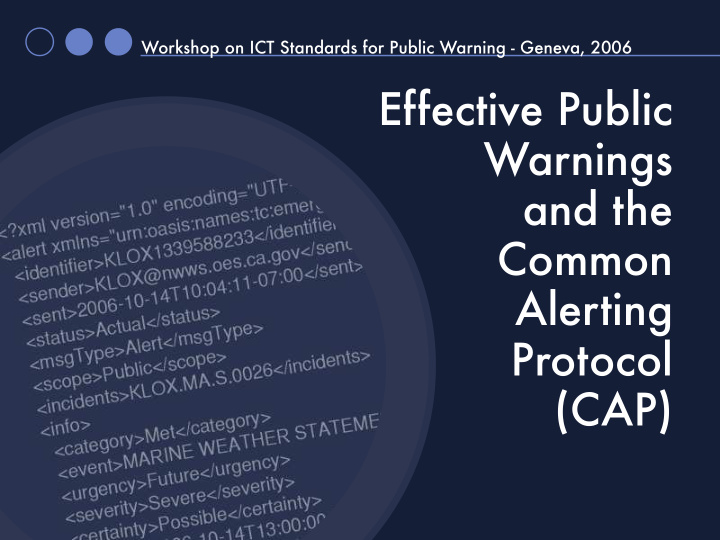



Workshop on ICT Standards for Public Warning - Geneva, 2006 Effective Public Warnings and the Common Alerting Protocol (CAP)
Goals of Public Warning Save lives Reduce losses Alleviate fear The measure of a warning is the change in action and attitude that results.
Effective Warning Systems Reach everyone at risk, wherever, whenever, doing whatever Don’t raise irrelevant alarms Easy to use Reliable and secure Deliver effective warning messages
Effective Warning Messages Accurate and specific Action oriented Understandable in terms of: Languages and special needs Prior knowledge and experience Timeframe and instructions
There is no “magic bullet” No single system or technology can ever solve the public warning problem alone: Limits of reliability Limits of reach Need for corroboration
Corroboration Most people will not act on the first warning message they receive Instead, they become vigilant and search for corroboration Only when persuaded it’s not a false alarm will people transform information into action
Challenges Many different warning systems Different capabilities, different procedures Social diversity - languages, needs Detecting patterns in activity Implementing best practices
Opportunities Digital control of most warning technologies Internet and other data networks Encryption and digital signatures Extensible Markup Language (XML) and other content standards
CAP Timeline 2000 - “Effective Disaster Warnings” study published 2001 - CAP Working Group and Partnership for Public Warning form; 2002 - CAP draft specification and prototype field trials
CAP Timeline 2003 - OASIS Emergency Management Technical Committee releases CAP 1.0 draft 2004 - CAP 1.0 adopted, international implementations begin 2005 - CAP 1.1 update 2006 - Broad global adoption, continuing standards advancement
Historically... Multiple systems Multiple purposes Multiple operators
Today’s reality... Single originator must activate each system individually
Using CAP... One activation triggers multiple systems Consistent, complete messages
The CAP Message info alert resource Language Message ID Description * Event Category Sender ID MIME Type Event Type Date/Time Sent File Size Response Type Alert Status * URI Alert Type Urgency Dereferenced URI Severity Password Digest Certainty Operator ID Audience Alert Scope Event Code Restriction Effective Date/Time Address area Onset Date/Time Handling Code Expires Date/Time Note Area Description * Sender Name Reference ID Polygon Headline Incident ID Circle Hazard Description Geocode Instructions Altitude Information URL Ceiling Contact Info Parameters
The Alert Block Basic information about this message: Date/Time Sender Message Type & Status Distribution Scope
Message Type Describes the general purpose of this message: Alert Initial information about an event or hazard Update New information updating an earlier message Cancel Cancels an earlier message Ack Acknowledges receipt and acceptance of a message Error Indicates rejection of a message (explained in Note) Draft Prepared language or pending release authority
Message Status Describes appropriate use of this message: Actual Refers to actual hazards or events Exercise Refers to simulated hazards of events, for exercise participants Test Technical testing, not actionable System Network internal messages, updates, etc.
Message Scope Describes the appropriate dissemination of this message: Public For general delivery to unrestricted audience and the public Restricted For delivery only according to a specified rule. Private For delivery only to specified addresses.
The Info Block Specifics of an event or a threat: Category and description Urgency / Severity / Certainty Timeframes Recommended action Supplemental information
Multiple Info Blocks Different languages Different instructions or timeframes for different areas Phased evacuation Evacuate vs shelter-in-place Watch vs. warning
Event Category (A perfect list is hard to find!) Geo Geophysical Met Meteorological Safety General emergency and public safety Security Law enforcement, military, homeland and private security Rescue Rescue and recovery Fire Fire suppression Health Public heath and medical Env Hazmat, pollution and other environmental Transport Public and private transportation Infra Utility, telecommunications, other infrastructure Other Not otherwise categorized
The U/S/C Model Traditional one- dimensional model of “priority” is expanded into a “3D” model that Threat expresses: or Event Severity Certainty Urgency
The U/S/C Model Traditional one- dimensional model of “priority” is expanded into a “3D” model that Threat expresses: or Event Severity Urgency (time) Certainty x Urgency
The U/S/C Model Traditional one- dimensional model of “priority” is expanded into a “3D” model that Threat expresses: or Event x Severity Urgency (time) Severity (impact) Certainty x Urgency
The U/S/C Model Traditional one- dimensional model of “priority” is expanded into a “3D” model that Threat expresses: or Event x Severity Urgency (time) Severity (impact) Certainty x x Certainty Urgency (probability)
Urgency In the U/S/C model Describes the time available to prepare: Immediate Responsive action should be taken immediately Expected Action within next hour Future Action in near future (typically 6-24 hours) Past Past, no preparatory action required Unknown Not known
Severity In the U/S/C model Describes the intensity of impact (if it occurs): Extreme Extraordinary or large-scale threat to life and property Severe Significant threat to life and property Moderate Potential threat to life and property Minor Limited threat to live and property Unknown Not known
Certainty In the U/S/C model Describes the issuer’s confidence that the event will occur or has occurred: Observed Definitely occurred or occurring Likely Likely, although not certain (p>50%) Possible Possible but not likely (p<50%) Unlikely Not expected to occur (p<5%) Unknown Not known
The Area Block Geographic target area: Text description and combo of: GIS Polygon (area) Point and Radius Geographic Code Optional altitude and ceiling
The Area Block Geospatial description may be based on administrative, predicted or observed scope of effects More precise targeting means fewer irrelevant warnings (“cry wolf”)
Multiple Area Blocks Multiple areas affected in same way and simultaneously: Multiple flood-plain areas along a river Multiple utility service zones Areas with different descriptions
The Resource Block “Attachment” of other content (binary, XML, etc.) Audio, images, maps, etc. Reference (by URI) preferred Inclusion (Base-64 encoded) for data-broadcast application
The Road Ahead Transport contexts Identity and authentication contexts From geocodes to geospatial descriptions Standard of practice - expectation management Standard refinement (GML and EDXL integration, ITU, etc.)
Contact for the Common Alerting Protocol project OASIS EM TC http://www.oasis-open.org/ committees/emergency/ Presented by Art Botterell acb @ incident.com
Recommend
More recommend